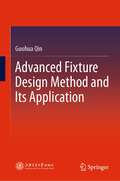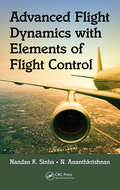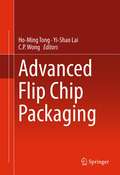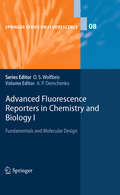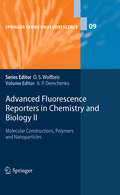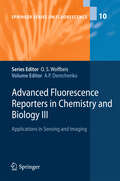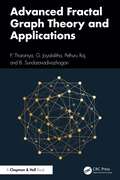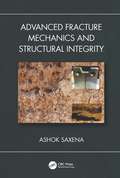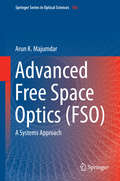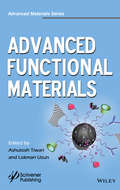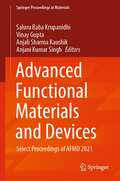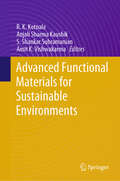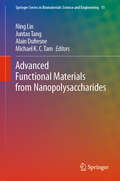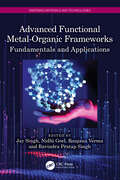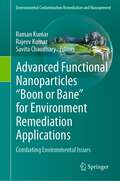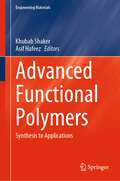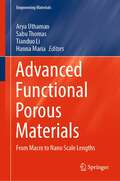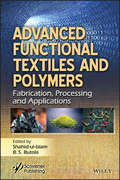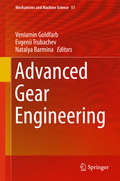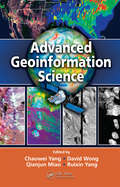- Table View
- List View
Advanced Fixture Design Method and Its Application
by Guohua QinThis book uses kinematics, mechanics, mathematics, and so on, to systematically propose the fixturing performance evaluation and fixturing layout planning method. The proposed method is a novel method, including the analysis method of locating determination, the analysis method of workpiece stability, the analysis method of clamping reasonability, the analysis method of workpiece attachment/detachment, the analysis method of locating accuracy, and the planning algorithm of locating point layout, the planning algorithm of clamping force, and so forth. It can enrich and develop the basic theory of computer aided fixture design, change the empirical method of fixture design. The combination of theoretical analysis and mathematical modeling technology can resolve the key problems in the process of fixture design, which will play a certain role in promoting the progress of manufacturing technology, improving the precision and level of product manufacturing, and meeting the higher and higher requirements of mechanical manufacturing industry.
Advanced Flight Dynamics with Elements of Flight Control
by Nandan K. Sinha N. AnanthkrishnanAdvanced Flight Dynamics aim to integrate the subjects of aircraft performance, trim and stability/control in a seamless manner. Advanced Flight Dynamics highlights three key and unique viewpoints. Firstly, it follows the revised and corrected aerodynamic modeling presented previously in recent textbook on Elementary Flight Dynamics. Secondly, it uses bifurcation and continuation theory, especially the Extended Bifurcation Analysis (EBA) procedure devised by the authors, to blend the subjects of aircraft performance, trim and stability, and flight control into a unified whole. Thirdly, rather than select one control design tool or another, it uses the generalized Nonlinear Dynamic Inversion (NDI) methodology to illustrate the fundamental principles of flight control. Advanced Flight Dynamics covers all the standard airplane maneuvers, various types of instabilities normally encountered in flight dynamics and illustrates them with real-life airplane data and examples, thus bridging the gap between the teaching of flight dynamics/ control theory in the university and its practice in airplane design bureaus. The expected reader group for this book would ideally be senior undergraduate and graduate students, practicing aerospace/flight simulation engineers/scientists from industry as well as researchers in various organizations. Key Features: Focus on unified nonlinear approach, with nonlinear analysis tools. Provides an up-to-date, corrected, and unified presentation of aircraft trim, stability and control analysis including nonlinear phenomena and closed-loop stability analysis. Contains a computational tool and real-life example carried through the chapters. Includes complementary nonlinear dynamic inversion control approach, with relevant aircraft examples. Fills the gap in the market for a text including non-linear flight dynamics and continuation methods.
Advanced Flip Chip Packaging
by C. P. Wong Yi-Shao Lai Ho-Ming TongAdvanced Flip Chip Packaging presents past, present and future advances and trends in areas such as substrate technology, material development, and assembly processes. Flip chip packaging is now in widespread use in computing, communications, consumer and automotive electronics, and the demand for flip chip technology is continuing to grow in order to meet the need for products that offer better performance, are smaller, and are environmentally sustainable.
Advanced Fluid Mechanics and Heat Transfer for Engineers and Scientists
by Meinhard T. SchobeiriThe current book, Advanced Fluid Mechanics and Heat Transfer is based on author's four decades of industrial and academic research in the area of thermofluid sciences including fluid mechanics, aero-thermodynamics, heat transfer and their applications to engineering systems. Fluid mechanics and heat transfer are inextricably intertwined and both are two integral parts of one physical discipline. No problem from fluid mechanics that requires the calculation of the temperature can be solved using the system of Navier-Stokes and continuity equations only. Conversely, no heat transfer problem can be solved using the energy equation only without using the Navier-Stokes and continuity equations. The fact that there is no book treating this physical discipline as a unified subject in a single book that considers the need of the engineering and physics community, motivated the author to write this book. It is primarily aimed at students of engineering, physics and those practicing professionals who perform aero-thermo-heat transfer design tasks in the industry and would like to deepen their knowledge in this area. The contents of this new book covers the material required in Fluid Mechanics and Heat Transfer Graduate Core Courses in the US universities. It also covers the major parts of the Ph.D-level elective courses Advanced Fluid Mechanics and Heat Transfer that the author has been teaching at Texas A&M University for the past three decades.
Advanced Fluorescence Reporters in Chemistry and Biology I: Fundamentals and Molecular Design (Springer Series on Fluorescence #8)
by Alexander P. DemchenkoThis volume is focused on one of the most important challenges in sensing and imaging technologies: the design of fluorescence reporters with advanced properties. Here organic dyes occupy leading positions, in tough competition with novel materials such as metal chelating complexes and semiconductor nanoparticles. 11 chapters written by top experts in the field show new possibilities in the design of organic dyes as fluorescent labels and reporters. They particularly highlight the progress that has been made in enhancing the response to intermolecular interactions and their excited-state reaction dynamics (intramolecular charge and proton transfers), and on the development of dyes with strong two-photon absorption and emitting in the near-IR region. Furthermore, fluorophores incorporated into new members of the green fluorescent protein family, an invaluable tool for live cell imaging, are examined.
Advanced Fluorescence Reporters in Chemistry and Biology II: Molecular Constructions, Polymers and Nanoparticles (Springer Series on Fluorescence #9)
by Alexander P. DemchenkoThis volume demonstrates the novel possibilities in sensing and imaging offered by the assembly of organic dyes into nanoparticles and nanocomposites and by the application of strongly fluorescent noble metal clusters and conjugated polymers. Its 14 chapters, written by top experts in this field, provide in-depth information on the coupling of organic dyes to different molecular and supramolecular structures, on their incorporation into polymeric nanoparticles and on the nanostructures that can be formed by some of the dyes. Bright and photostable several-atom clusters of gold and silver are examined. Finally, the revolutionary changes in sensing technologies attending the advent of conjugated polmyers and the advances in their application are discussed.
Advanced Fluorescence Reporters in Chemistry and Biology III: Applications in Sensing and Imaging (Springer Series on Fluorescence #10)
by Alexander P. DemchenkoThe key element of any fluorescence sensing or imaging technology is the fluorescence reporter, which transforms the information on molecular interactions and dynamics into measurable signals of fluorescence emission. This book, written by a team of frontline researchers, demonstrates the broad field of applications of fluorescence reporters, starting from nanoscopic properties of materials, such as self-assembled thin films, polymers and ionic liquids, through biological macromolecules and further to living cell, tissue and body imaging. Basic information on obtaining and interpreting experimental data is presented and recent progress in these practically important areas is highlighted. The book is addressed to a broad interdisciplinary audience.
Advanced Fractal Graph Theory and Applications
by P. Tharaniya G. Jayalalitha Pethuru Raj B. SundaravadivazhaganThis book explores the dynamic interplay between fractals and graph theory, two powerful mathematical tools with vast applications. It presents a strategic combination and the synergistic use of these disciplines to address real-world problems and challenges. The book begins with an introduction to the basic concepts of fractals and graph theory and goes on to explore the applications in various domains, including natural phenomena modeling, scheduling, and network optimisation.This book: Illustrates the innovative ways fractals and graph theory can be combined, laying the groundwork for future applications across various industries Introduces the fundamental concepts and principles of both fractals and graph theory in detail, making it accessible to a broad audience, including those new to these topics Explores practical applications in image processing, network optimisation, social network analysis, and more, demonstrating the real-world impact of these mathematical tools Analyses advanced techniques in graph theory, such as matching, domination, and colouring, with practical examples and case studies Highlights the latest research advancements in fractal graph theory, showcasing its potential for future developments and applications This book is for students, researchers, and professionals in mathematics, computer science, engineering, and related fields.
Advanced Fracture Mechanics and Structural Integrity
by Ashok SaxenaAdvanced Fracture Mechanics and Structural Integrity is organized to cover quantitative descriptions of crack growth and fracture phenomena. The mechanics of fracture are explained, emphasizing elastic-plastic and time-dependent fracture mechanics. Applications are presented, using examples from power generation, aerospace, marine, and chemical industries, with focus on predicting the remaining life of structural components and advanced testing metods for structural materials. Numerous examples and end-of-chapter problems are provided, along with references to encourage further study.The book is written for use in an advanced graduate course on fracture mechanics or structural integrity.
Advanced Free Space Optics: A Systems Approach (Springer Series in Optical Sciences #186)
by Arun K. MajumdarThis title provides a comprehensive, unified tutorial covering the most recent advances in the emerging technology of free-space optics (FSO), a field in which interest and attention continue to grow along with the number of new challenges. This book is intended as an all-inclusive source to serve the needs of those who require information about the fundamentals of FSO, as well as up-to-date advanced knowledge of the state-of-the-art in the technologies available today. This text is intended for graduate students, and will also be useful for research scientists and engineers with an interest in the field. FSO communication is a practical solution for creating a three dimensional global broadband communications grid, offering bandwidths far beyond what is possible in the Radio Frequency (RF) range However, the attributes of atmospheric turbulence and scattering impose perennial limitations on availability and reliability of FSO links From a systems point-of-view, this groundbreaking book provides a thorough understanding of channel behavior, which can be used to design and evaluate optimum transmission techniques that operate under realistic atmospheric conditions. Topics addressed include: * FSO Physical and Statistical Models: Single/Multiple Inputs/Outputs * Understanding FSO: Theory and Systems Analysis * Modulation and Coding for Free-Space Optical Channels * Atmospheric Mitigation and Compensation for FSO Links * Non-line-of-sight (NLOS) Ultraviolet and Indoor FSO Communications * FSO Platforms: UAV and Mobile * Retromodulators for Free Space Data links * Hybrid Optical RF Communications * Free-space and Atmospheric Quantum Communications * Other related topics: Chaos-based and Terahertz (THz) FSO Communications
Advanced Functional Materials
by Ashutosh Tiwari Lokman UzunBecause of their unique properties (size, shape, and surface functions), functional materials are gaining significant attention in the areas of energy conversion and storage, sensing, electronics, photonics, and biomedicine. Within the chapters of this book written by well-known researchers, one will find the range of methods that have been developed for preparation and functionalization of organic, inorganic and hybrid structures which are the necessary building blocks for the architecture of various advanced functional materials. The book discusses these innovative methodologies and research strategies, as well as provides a comprehensive and detailed overview of the cutting-edge research on the processing, properties and technology developments of advanced functional materials and their applications. Specifically, Advanced Functional Materials: Compiles the objectives related to functional materials and provides detailed reviews of fundamentals, novel production methods, and frontiers of functional materials, including metalic oxides, conducting polymers, carbon nanotubes, discotic liquid crystalline dimers, calixarenes, crown ethers, chitosan and graphene. Discusses the production and characterization of these materials, while mentioning recent approaches developed as well as their uses and applications for sensitive chemiresistors, optical and electronic materials, solar hydrogen generation, supercapacitors, display and organic light-emitting diodes, functional adsorbents, and antimicrobial and biocompatible layer formation. This volume in the Advanced Materials Book Series includes twelve chapters divided into two main areas: Part 1: Functional Metal Oxides: Architecture, Design and Applications and Part 2: Multifunctional Hybrid Materials: Fundamentals and Frontiers
Advanced Functional Materials and Devices: Select Proceedings of AFMD 2021 (Springer Proceedings in Materials #14)
by Saluru Baba Krupanidhi Vinay Gupta Anjali Sharma Kaushik Anjani Kumar SinghThis book presents the select proceedings of the International Conference on Advanced Functional Materials and Devices (AFMD 2021). It highlights the advancements in area of functional materials which includes electronic, magnetic, optical, adaptive and dielectric materials that are required to develop new functionalities with better performance in this new era of technology. The topics covered include materials for energy harvesting, biomedical applications, environmental monitoring, photonics and optoelectronic devices, strategic applications and high energy physics. This book will be a useful reference for beginners, researchers, academicians and professionals working in the area of material science and its allied fields.
Advanced Functional Materials for Optical and Hazardous Sensing: Synthesis and Applications (Progress in Optical Science and Photonics #27)
by Rakesh Kumar Sonker Kedar Singh Rajendra SonkawadeThis book highlights the significance and usefulness of nanomaterials for the development of sensing devices and their real-life applications. The book also addresses various means of synthesizing functional materials, e.g., hydrothermal deposition process, electrospinning, Ostwald ripening, sputtering heterogeneous deposition, liquid-phase preparation, the vapor deposition approach, and aerosol flame synthesis. It presents an informative overview of the role of functional materials in the development of advanced sensor devices at the nanoscale and discusses the applications of functional materials in different forms prepared by diverse techniques in the field of optoelectronics and biomedical devices. Major features, such as type of advanced functional, fabrication methods, applications, tasks, benefits and restrictions, and saleable features, are presented in this book. Advanced functional materials for sensing have much wider applications and have an enormous impact on our environment.
Advanced Functional Materials for Sustainable Environments
by Anjali Sharma Kaushik R. K. Kotnala S. Shankar Subramanian Amit K. VishwakarmaThe book gives an insight into the latest research going on worldwide in the areaof functional materials that specifically utilized for the energy harvesting,storage, and environmental monitoring. Since the technology is moving very fastday by day, it has become a need of hour to stay updated with recentadvancements in materials which include electronic, magnetic, optical,adaptive, dielectric materials, etc., that are required to develop newfunctionalities with better performance that is beneficial for sustainableenvironment. The broad areas that are covered in the book include the knowledge of wide range ofmaterials for energy harvesting, energy storage, and sensors for environmentalmonitoring. This book is a value additional reference for beginners,researchers, and academicians regarding the new functionalmaterials for device applications. This book covers a wide range of topics:multifunctional materials, 2D materials, sensing materials, materials forenvironmental studies, DFT and solar simulation of materials, perovskite anddouble perovskite materials, materials for energy conversion and storage, smartmaterials, advanced functional materials, polymeric materials, composites,materials for sustainable development, nanomaterials, and thin films.
Advanced Functional Materials from Nanopolysaccharides (Springer Series in Biomaterials Science and Engineering #15)
by Alain Dufresne Ning Lin Juntao Tang Michael K. C. TamThis book describes the latest research on nanopolysaccharides in the development of functional materials, from their preparation, properties and functional modifications to the architecture of diverse functional materials. Polysaccharide-based nanoparticles, including nanocellulose, nanochitin, and nanostarch have attracted interest in the field of nanoscience, nanotechnology, and materials science that encompasses various industrial sectors, such as biomedicine, catalyst, coating, energy, optical materials, environmental materials, construction materials, and antibacterial materials. This book establishes a fundamental framework, highlighting the architecture strategies of typical functional systems based on nanopolysaccharides and integrated analysis of their significant influence and properties to various functional behaviors of materials, to help readers to fully understand the fundamental features of nanopolysaccharides and functional materials. Addressing the potential for practical applications, the book also covers the related industrial interests and reports on highly valued products from nanopolysaccharides, providing ideas for future studies in the area. Intended both for academics and professionals who are interested in nanopolysaccharides, it is also a valuable resource for postgraduate students, researchers, and engineers involved in R&D of natural polymers, nanotechnology, and functional materials.
Advanced Functional Materials: Proceedings Of Chinese Materials Conference 2017 (Materials Science Forum Vol. 815 Ser.)
by Yafang HanThis proceedings volume gathers selected papers presented at the Chinese Materials Conference 2017 (CMC2017), held in Yinchuan City, Ningxia, China, on July 06-12, 2017.
Advanced Functional Metal-Organic Frameworks: Fundamentals and Applications (Emerging Materials and Technologies)
by Ravindra Pratap Singh Jay Singh Nidhi Goel Ranjana VermaDue to the structural flexibility, large surface area, tailorable pore size and functional tenability, metal-organic frameworks (MOFs) can lead to materials with unique properties. This book covers the fundamental aspects of MOFs, their synthesis and modification, including their potential applications in different domains. The major focus is on applications including chemical, biosensors, catalysis, drug delivery, supercapacitors, energy storage, magnetics and their future perspectives. The volume: Covers all aspects related to metal-organic frameworks (MOFs), including characterization, modification, applications and associated challenges Illustrates designing and synthetic strategies for MOFs Describes MOFs for gas adsorption, separation and purification, and their role in heterogeneous catalysis Covers sensing of different types of noxious substances in the aqueous environment Includes concepts of molecular magnetism, tunable magnetic properties and future aspects This book is aimed at graduate students, and researchers in material science, coordination and industrial chemistry, chemical and environmental engineering and clean technologies.
Advanced Functional Nanoparticles "Boon or Bane" for Environment Remediation Applications: Combating Environmental Issues (Environmental Contamination Remediation and Management)
by Rajeev Kumar Raman Kumar Savita ChaudharyThis textbook provides an overview of applications of advanced nanomaterials, basic lab set up and requirements in for their synthesis, techniques and career scope of nanotechnology in industries and research. Pollution of air, water, soil is an ever increasing environmental problem attributed to increasing population, global industrialization and unplanned urbanization, has acquired alarming dimensions. It is the most dangerous and worst problem that puts the lives of people, animals, and plants on the earth in danger. An effective, efficient and sustainable approach for managing pollution related problems requires the utmost attention of the scientific community to tackle this menace for the society to lead a healthy and quality life. A number of techniques and books, literatures have been developed in recent years to treat environmental contaminants. However, most of these are not economically viable, environmentally benign and suffer due to cumbersome multi-step manipulations. The purpose of this textbook is to inform students about the application of functionalized nanoparticles as a new approach to supplement traditional treatment methods in cost and time effective manner. The simplistic means to assemble nanoparticles to the constituents of next generation technologies in environment cleanup and sensing are the main objectives of the book. The toxicological footprinting of released advanced functional nanomaterials in ecosystem will also be discussed in the book.
Advanced Functional Polymers: Synthesis to Applications (Engineering Materials)
by Khubab Shaker Asif HafeezThis book highlights different domains of functional polymers from membranes and coatings to composite materials. It includes their synthesis routes and techniques, characterization, properties, and applications. The book also provides the basics and advances about different functional polymers and composites with an up-to-date progress in the field of research and their application on a domestic and industrial scale. The main topics to be covered include polymeric membranes, paints and coatings, smart polymers, self-healing elastomers, biodegradable polymers, food packaging, and functional composite materials.
Advanced Functional Porous Materials: From Macro to Nano Scale Lengths (Engineering Materials)
by Sabu Thomas Tianduo Li Arya Uthaman Hanna MariaThis book presents synthesis, characterization, and applications of macroporous, mesoporous, nanoporous, hierarchical porous, porous metals, and porous ceramics. Special emphasis is given to the preparation of porous activated carbon materials and porous ionic liquid-derived materials for CO2 emissions mitigation. Additionally, a chapter includes the physical and mathematical modeling in porous media. Many analytical techniques for characterization are discussed in this book. Also, the biomedical and industrial applications of porous materials in adsorption, catalysis, biosensors, drug delivery, nanotechnology are described. The content helps solving fundamental and applied problems in porous materials with length scales varying from macro- to nano-level.
Advanced Functional Textiles and Polymers: Fabrication, Processing and Applications
by B. S. Butola Shahid-Ul-IslamThis book on advanced functional textiles and polymers will offer a comprehensive view of cutting-edge research in newly discovered areas such as flame retardant textiles, antimicrobial textiles, insect repellent textiles, aroma textiles, medical-textiles, smart textiles, and nano-textiles etc. The second part the book provides innovative fabrication strategies, unique methodologies and overview of latest novel agents employed in the research and development of functional polymers.
Advanced Gear Engineering (Mechanisms and Machine Science #51)
by Veniamin Goldfarb Natalya Barmina Evgenii TrubachevThis book covers recent developments in practically all spheres of mechanical engineering related to different kinds of gears and transmissions. Topics treated range from fundamental research to the advanced applications of gears in various practical fields, prospects of manufacturing development, results and trends of numerical and experimental research of gears, new approaches to gear design and aspects of their optimization synthesis.
Advanced Geoinformation Science
by David Wong Chaowei Yang Ruixin Yang Qianjun MiaoMany of the challenges of the next century will have physical dimensions, such as tsunamis, hurricanes, and climate change as well as human dimensions such as economic crises, epidemics, and emergency responses. With pioneering editors and expert contributors, Advanced Geoinformation Science explores how certain technical aspects of geoinformation
Advanced Geotechnical Analyses: Developments in Soil Mechanics and Foundation Engineering - 4
by P. K. Banerjee R. ButterfieldThe chapters in this book show that a careful blend of engineering judgement and advanced principles of engineering mechanics may be used to resolve many complex geotechnical engineering problems. It is hoped that these may inspire the geotechnical engineering practice to make more extensive use of them in future.
Advanced Geotechnical Engineering: Soil-Structure Interaction using Computer and Material Models
by Chandrakant S. Desai Musharraf ZamanSoil-structure interaction is an area of major importance in geotechnical engineering and geomechanics Advanced Geotechnical Engineering: Soil-Structure Interaction using Computer and Material Models covers computer and analytical methods for a number of geotechnical problems. It introduces the main factors important to the application of computer
